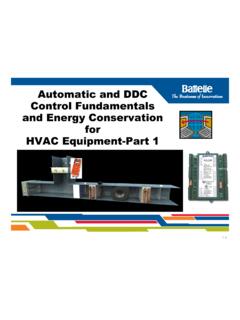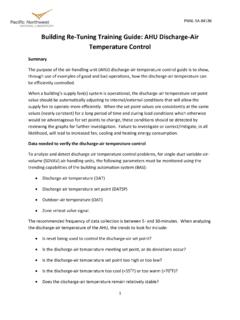Transcription of Automatic and DDC Control Fundamentals and Energy ...
1 Automatic and DDC Control Fundamentalsand Energy Conservation for HVAC Equipment-Part 11-1 DisclaimerDisclaimerThis presentation was prepared specifically for use as college training material It shall not be modifiedcollege training material. It shall not be modified without the consent of the authors. This presentation represents sponsored research activities. Neither the Client nor Battelle warrantsactivities. Neither the Client nor Battelle warrants the accuracy, completeness or usefulness of the information. Reference herein to any specific ild ti b t dcommercial product, process or service by trade names or manufacturer does not constitute an endorsement or recommendation. 1-2 PNWD-SA-8834 DDC Controls and Energy Conservation for HVAC Eq ipment AgendaHVAC Equipment of DDC Controls Project2 HVAC Ct l P i i Control Standards and Networks4 Vendor Examplesof DDCS oftware Programming Examples of DDC Software Programming and Operator Rooftop and Central AHU HVAC Control SystemsandApplicationsSystems and Maintenance and Service of DDC Common Control Problems and Fixing the and Verifying Energy Savings of the DDC Controls1-3 PNWD-SA-8834 Part 1 HVAC Control PrinciplesHVAC Control of Battelle Pacific NW Division of Controls Components of Control Loops, Open vs.
2 Closed Control Cycle and Control Actions7Th ESfCt l S Energy Sources for Control Point Types1-4 PNWD-SA-8834 Part 2 Control Applications, Networks, Programming, Maintenance, and Energy SavingsEnergy Control Networks and Standards and Examples of DDC Software Programming and Operator maintenance and service of DDC DDC controls to save energy1-5 PNWD-SA-8834ggySection 1 Introduction of DDC Controls Project Purpose of this project is to provide HVAC dtiltiltWhitStteducational materials to Washington State community colleges to educate students who have chosen or may chose career paths related to HVAC chosen or may chose career paths related to HVAC servicing and building Energy management fields1-6 PNWD-SA-8834 Section 2 HVAC Control PrinciplesHVAC Control PrinciplesThe Purpose of Temperature Controls Control systems are the brains of HVAC equipment to iti hf tPit dbl iAHUthtmaintain human comfort.
3 Pictured below is an AHU that serves only one zone. This type of AHU is called a single zone AHU. In the example, a temperature sensor (stat) sends ilttl lhih d ilt la signal to a Control panel, which sends a signal to a valve. 1-7 PNWD-SA-8834 Courtesy TAC Controls/Schneider ElectricSection 3K Ct f Ctl Key Components of a Control System Include:1-8 PNWD-SA-8834 Courtesy TAC Controls/Schneider ElectricSensors Modern HVAC Sensors Include: Humidity and temperature transmitters CO2for indoor air quality (IAQ) utilizing ddtltiltidemand Control ventilation Power meters Branch circuit monitors Branch circuit monitors Energy meters1-9 PNWD-SA-8834 Courtesy Veris IndustriesSensors A sensor monitors and measures a variable. The HVAC variables are temperature, humidity, flow, and pressure Different types of signals are produced bypressure. Different types of signals are produced by different types of sensors. They include: Electric sensorsElectric sensors Pneumatic sensorsElectronic sensors Electronic sensorsAn example of a sensor is shown here.
4 While it may appear to be a thermostat, it is a remote sensor with a remotesetpointdial The controller is in another1-10 PNWD-SA-8834a remote setpointdial. The controller is in another TAC Controls/Schneider ElectricPneumatic Sensors/Transmitters Pneumatic controls sensors or transmitters sense the variable and produce a 3 psig to 15sense the variable and produce a 3 psig to 15 psig (pound per square inch, gauge), [20 kPa (kiloPascals) -105 kPa] signal over a particular transmitter's range. 1-11 PNWD-SA-8834 Courtesy Johnson ControlsElectronic Sensors Include: Resistance sensors are resistance temperature devices (RTDs) and are used in measuringdevices (RTDs), and are used in measuring temperature. Examples are Balco elements, copper platinum, 10K thermistors, and 30K thermistors. Voltage sensors could be used for temperature, humidity and pressure. Typical ranges are 0 to 5 Vd (V lt ditt) 1t 11 Vdd0t 10 Vdc (Volts direct current), 1 to 11 Vdc, and 0 to 10 Vdc.
5 Ctldb dft t Current sensors could be used for temperature, humidity, and pressure. The typical current range is 4 to 20 mA (milliamps). 1-12 PNWD-SA-8834(p)1000 (Ohms) Balco PTC Electronic Temperature SensorsElectronic Temperature Sensors The resistance outputs of a electronic Balco temperature sensor follow the diagrams below: When 1000 ohms is measured across the Balco element, the temperature is approximately 70 F(21 C) As the temperaturetemperature is approximately 70 F (21 C). As the temperature increases, the resistance changes ohms per 1 F ( ohms per 1 C). In a Balco temperature sensor, as the ttithititilltemperature increases, the resistance increases proportionally in a positive direction. This is known as a positive temperature coefficient (PTC) sensor. However, many temperature sensors idd thi tdfNti1-13 PNWD-SA-8834are considered thermistors, and perform as Negative temperature coefficients (NTC).Comparison of Common Temp Sensorspp1-14 PNWD-SA-8834 Courtesy Omega ControlsControllers Can Include.
6 Electric ControlsPneumatic ControlsDDCC ontrols1-15 PNWD-SA-8834 Electronic ControlsCourtesy Johnson, Honeywell, and Alerton ControlsControllers basic principlesthe controller receives the input And processes an output1-16 PNWD-SA-8834 Electronic Control Systemy1-17 PNWD-SA-8834 Courtesy Honeywell ControlsPneumatic Controller SystemPneumatic Controller System Branch or ControlDamper Branch or ControlDamperSensorBranch or Control PressureDamperSensorBranch or Control PressureDamperControllerOperatorFilter Main or Supply ControllerOperatorFilter Main or Supply PressureRegulatorpp yPressureCompressorPressureRegulatorpp yPressureCompressorThermostatValveActuat orThermostatValveActuator1-18 PNWD-SA-8834 ValveValveCourtesy Northwest Energy Efficiency CouncilThe DDC controller receives the inputThe DDC controller receives the inputfrom the sensor, performs a logic function and processes an outputfunction, and processes an output1-19 PNWD-SA-8834 Courtesy DDC Online OrgController Action-Direct or ReverseIllustration1-20 PNWD-SA-8834 Courtesy Honeywell ControlsController Direct Action-Illustration1-21 PNWD-SA-8834 Courtesy TAC Controls/Schneider ElectricController Direct Action-Illustration This relationship between the input to a controller (temperature) and its output (current) can be(temperature) and its output (current) can be displayed on a graph as follows:1-22 PNWD-SA-8834 Courtesy TAC Controls/Schneider ElectricController Reverse Action-IllustrationController Reverse ActionIllustration1-23 PNWD-SA-8834 Courtesy TAC Controls/Schneider ElectricController Reverse Action-IllustrationController Reverse ActionIllustration This relationship can is displayed on a graph as follows:follows.
7 1-24 PNWD-SA-8834 Courtesy TAC Controls/Schneider ElectricControlled DevicesControlled DevicesControl ValvesControl Valves two-way Control ValvesUsed with differential pressure (DP) sensors and VSD pump systems on primary and secondary loops three -way ( mixing or diverting )Press re independent Control al es Pressure independent Control valvesAutomatic dampersAutomatic dampersDamper operatorsVSDs: variable speed drives1-25 PNWD-SA-8834 VSDs: variable speed drivesCourtesy BelimoControlled DevicesValvesMixing ValveDiverting ValvegTilThWMii1-26 PNWD-SA-8834 Typical three -Way mixing and diverting ValvesTypical Single - and Double-SeatedTwo-Way ValvesCourtesy BelimoThe Present Control Systems Pressure independent Control valvesyUse Control valves that are:Pressure independent Control valves No Cv required, reduced pumping costs, higher efficiency, easy to Flow Control ValvesExamples of 2-Way and 3-Way Control Valves1-28 PNWD-SA-8834 Northwest Energy Efficiency CouncilDampers: Types, Actuators, and Characteristicsand Characteristics Economizers on many central AHUs are custom ordered for the job specific custoo de ed o t e job spec crequirements Economizers on packaged RTUs are normally ordered as an option with thenormally ordered as an option with the package Control Dampers Can Be Either:PlllddParallel or opposed dampers1-29 PNWD-SA-8834 Parallel Blade Opposed BladeEconomizer Damper Actuator Typesare either.
8 ElectricElectronicPneumaticElectricElect ronicPneumatic 1-30 PNWD-SA-8834 Economizer Damper Actuatorswill have either direct connect actuators bolted will have either direct connect actuators bolted directly to the damper or they will be installed with a shaft and linkage arrangement (more prone to fail)1-31 PNWD-SA-8834 Direct Connect ActuatorDamper Connected to Actuator Via Shaft and CouplingParallel Blade Damper Characteristicshave poor linear controlp1-32 PNWD-SA-8834 Courtesy & Damper Characteristicshave better linear control1-33 PNWD-SA-8834 Courtesy & Actuators can be Controlled by :py Voltage (0-10 Vdc or 2-10 Vdc) Current (4-20mA) Fltii t (biltl) Floating point (binary pulse to open or close) PWM-pulse width modulated Resistance (0-135 ohms)Resistance (0135 ohms)1-34 PNWD-SA-8834 Example of analog Control using 4-20mA or 2-10 VdcCourtesy Belimo Electronic Variable FD i(VSD )Frequency Drives (VSDs) Vary frequency of motor to Control speed Often called VSDs VFDs or ASDs Often called VSDs, VFDs, or ASDs1-35 PNWD-SA-8834 DDC Control systems have variable f()frequency drives (VFDs) asstandard equipment on.
9 Cli Cooling towers AHU s and VAV fans Pumps Chillers1-36 PNWD-SA-8834 Variable Speed DrivesVariable Speed Drives1-37 PNWD-SA-8834 Courtesy ABB ControlsReview of the Key Control Components Components Exercise-identify the sensors, controllers, and controlled devices1-38 PNWD-SA-8834 Courtesy TAC Controls/Schneider ElectricReview of the Key Control yComponents Exercise-connect the sensor, controller, and controlled device in the proper ordercontrolled device in the proper Alerton and BelimoReview of Control ActionExercisethe Control drawing below has a Exercise-the Control drawing below has a direct acting controller, with a NO valve. Show the correct action with arrows at each t h d f li dcomponent when used for cooling 1-40 PNWD-SA-8834 Courtesy TAC Controls/Schneider Electric and BelimoReview of Control ActionExercise-Circle the correct TAC Controls/Schneider ElectricReview of Control ActionExerciseCircle the correct answerExercise-Circle the correct TAC Controls/Schneider ElectricReview of Control ActionExercise-Circle the correct TAC Controls/Schneider ElectricReview of the Key Control Components Components Exercise-Identify the parallel vs.
10 Opposed blade dampers and the 3-way mixing vs. diverting 1-44 PNWD-SA-8834 Courtesy Belimo _____ _____ _____ _____ Section 4 Section 4 Basic Control Loop PrinciplesControllers can be either l d LCllid fdb kdl closed or open Loop Closes loops provide feedback-good Control Open loops have no feedback-poor control1-45 PNWD-SA-8834 Basic Closed-Loop-ExampleThe sensor feeds back to the controller1-46 PNWD-SA-8834 Courtesy DDC Online OrgOpen Loop Controlshave no feedback to the controller1-47 PNWD-SA-8834 Courtesy DDC Online OrgClosed vs. Open Loop ControlIllustrationNotice, averaging bulb is closed loop in supply air, but T-STAT between filter and coil is open Northwest Energy Efficiency CouncilSection 5 Control TerminologySetpoint, offset, and Control pointSetpoint, offset, and Control pointThrottling rangeSpan and rangepgAuthorityCalibrationAnalog and digitalThermostat as sensor-controller1-49 PNWD-SA-8834 SetpointSetpoint is the desired condition of a variable that is to be maintained, such as temperature.






